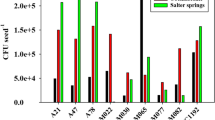Abstract
Laboratory, growth chamber and field experiments were conducted to select among 226 isolates of Rhizobium meliloti for the ability to grow, nodulate alfalfa (Medicago sativa L.) and support N2-dependent plant growth between 9° and 12°C. There was wide variation in the abilities of R. meliloti isolates to grow and form nodules at 10°C. Culture doubling times (td) varied from 1 to 155h, and the number of nodules formed on alfalfa in growth pouches in 2 weeks varied from 0 to 3.8 nodules per plant. Nodulation occurred at 9°C, but there was no significant N2-dependent plant growth at this temperature. However, several isolates of R. meliloti had the ability to nodulate alfalfa and produce N2-dependent growth at root temperatures between 10° and 12°C root temperature than did 14 other isolates tested. In field experiments, inoculation with strain NRG-34 resulted in greater nodule numbers, nodule weight, proportion of nodules occupied by the inoculant strain and plant weight than did inoculation with a commercial strain (NRG-185). These results permitted selection of a strain with better low-temperature competitive abilities than the currently available commercial strains.
Similar content being viewed by others
References
Brockwell J 1963 Accuracy of a plant-infection technique for counting populations of Rhizobium trifolii. Appl. Microbiol. 11, 377–383.
Carder A C 1965 Climate of the upper Peace River region, Canada Department of Agriculture, Ottawa. 19p.
Cralle H T and Heichel G H 1982 Temperature and chilling sensitivity of nodule nitrogenase activity of unhardened alfalfa. Crop Sci. 21, 300–304.
Drew S W 1981 Liquid culture. In Manual of Methods for General Bacteriology. Eds. PGerhardt, R G EMoory, R NCostilow, E WNester W AWood, N RKrieg and G BPhillips. pp 151–217. American Society For Microbiology, Washington, DC.
Duke S H, Schader L E, Henson C A, Servaites J C, Vogelzang R D and Pendleton F W 1979 Low root temperature effects on soybean nitrogen metabolism and photosynthesis. Plant Physiol. 63, 956–962.
Olsen P E, Rice W A, Stemke G W and Page W J 1983 Strain-specific serological techniques for the identification of Rhizobium meliloti in commercial alfalfa inoculants. Can. J. Microbiol. 29, 225–230.
Olsen P E and Rice W A 1984 Minimal antigenic characterization of eight Rhizobium meliloti strains. Can. J. Microbiol. 30, 1093–1099.
Olsen P, Wright S, Collins M and Rice W 1994 Patterns of reactivity between a panel of monoclonal antibodies and forage Rhizobium strains. Appl. Environ. Microbiol. 60, 654–661.
Prevost D, Bordeleau L M, Caudry-Reznick S, Schulman H M and Antoun H 1987 Characteristics of rhizobia isolated from three legumes indigenous to the Canadian high arctic: Astragalus alpinus, Oxytropis maydelliana and Oxytropis arctobia Plant and Soil 98, 313–324.
Rice W A 1980 Seasonal patterns of nitrogen fixation and dry matter production by clovers grown in the Peace River region. Can. J. Plant Sci. 60, 847–858.
Rice W A 1982 Performance of Rhizobium meliloti strains selected for low-pH tolerance. Can. J. Plant Sci. 62, 941–948.
Rice W A and Olsen P E 1988 Root temperature effects on competition for nodule occupancy between two Rhizobium meliloti s strains. Biol. Fertil. Soils 6, 137–140.
Rice W A and Olsen P E 1992 Effects of inoculation method and size of Rhizobium meliloti population in the soil on nodulation of alfalfa. Can. J. Soil Sci. 72, 57–67.
Rice W A and Olsen P E 1993 Root nodule bacteria and nitrogen fixation. In Soil Sampling and Methods of Analysis. Ed. M RCarter. pp 303–317. Lewis Publishers, Boca Raton.
Roughley R J and Dart P J 1970 Root temperature and root-hair infection of Trifolium subterraneum L.cv. Cranmore. Plant and Soil 32, 518–520.
Trinick M J 1982 Biology. In Nitrogen Fixation, Volume 2: Rhizobium. Ed. W JBroughton. pp 76–146. Claredon Press, Oxford.
Vincent J M 1970 A Manual for the Practical Study of Root-Nodule Bacteria. IBP Handbook No. 15. Blackwell Scientific Publications Ltd., Oxford. 164p.
Author information
Authors and Affiliations
Rights and permissions
About this article
Cite this article
Rice, W.A., Olsen, P.E. & Collins, M.M. Symbiotic effectiveness of Rhizobium meliloti at low root temperature. Plant Soil 170, 351–358 (1995). https://doi.org/10.1007/BF00010489
Received:
Accepted:
Issue Date:
DOI: https://doi.org/10.1007/BF00010489




